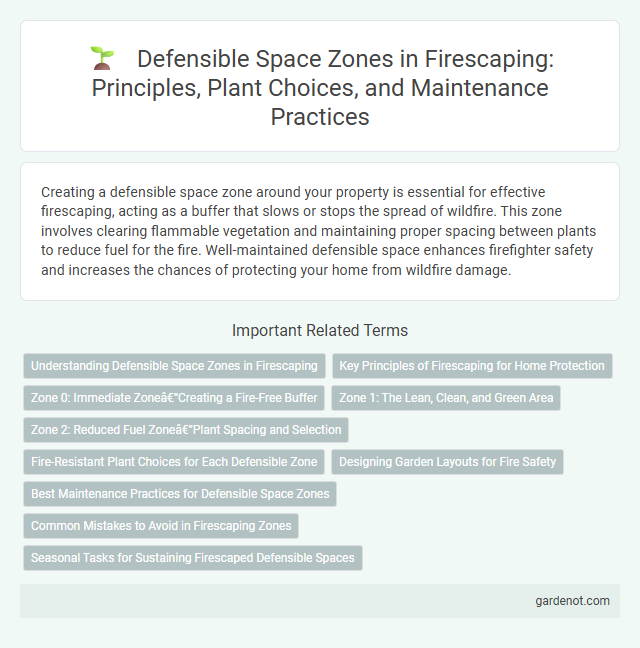Creating a defensible space zone around your property is essential for effective firescaping, acting as a buffer that slows or stops the spread of wildfire. This zone involves clearing flammable vegetation and maintaining proper spacing between plants to reduce fuel for the fire. Well-maintained defensible space enhances firefighter safety and increases the chances of protecting your home from wildfire damage.
Understanding Defensible Space Zones in Firescaping
Defensible space zones in firescaping refer to strategically managed areas around a property designed to slow or stop the spread of wildfire by reducing fuel load. These zones are typically divided into three categories: the immediate zone (0-5 feet), which focuses on hardscaping and removing combustible materials; the intermediate zone (5-30 feet), emphasizing spacing and pruning of vegetation; and the extended zone (30-100 feet), where vegetation management minimizes wildfire intensity. Properly understanding and implementing these zones significantly enhances a property's resistance to wildfire and improves firefighter access and safety.
Key Principles of Firescaping for Home Protection
Creating a defensible space zone around your home involves implementing key firescaping principles such as maintaining a minimum of 30 feet of clearance between vegetation and structures, using fire-resistant plants, and regularly removing dead or dry foliage to reduce wildfire fuel. Strategic spacing of trees and shrubs, combined with proper irrigation, minimizes fire intensity and improves firefighter access during emergencies. Employing hardscape elements like gravel or stone mulch further enhances this defensible space by acting as natural firebreaks around your property.
Zone 0: Immediate Zone—Creating a Fire-Free Buffer
Zone 0, the Immediate Zone in defensible space, extends 0 to 5 feet from a building and focuses on creating a fire-free buffer by removing all combustible materials, including dead vegetation, flammable mulch, and wooden structures. Maintaining non-flammable surfaces such as stone, gravel, or concrete, along with regularly cleaning gutters and roofs, significantly reduces the risk of fire ignition. Proper management in this closest zone is critical to preventing flames or embers from directly igniting the structure during a wildfire.
Zone 1: The Lean, Clean, and Green Area
Zone 1, known as the Lean, Clean, and Green Area, is crucial for creating a defensible space around a home by minimizing flammable vegetation within 5 to 30 feet of the structure. This zone emphasizes regularly removing dead plants, leaves, and pine needles while maintaining well-irrigated and low-growing, fire-resistant vegetation to reduce fuel for wildfires. Proper management of Zone 1 improves firefighter access and protects the home from embers and radiant heat during a fire event.
Zone 2: Reduced Fuel Zone—Plant Spacing and Selection
Zone 2: Reduced Fuel Zone emphasizes careful plant selection and strategic spacing to minimize wildfire fuel density around structures. Selecting fire-resistant plants and maintaining adequate distance between them disrupts fire spread and reduces heat intensity. Regular maintenance such as pruning and removing dead vegetation ensures this zone effectively decreases wildfire risk.
Fire-Resistant Plant Choices for Each Defensible Zone
Selecting fire-resistant plants for defensible space zones greatly reduces wildfire risk by slowing fire spread and protecting structures. In the immediate zone (0-5 feet), use low-growing, flame-resistant plants like succulents and well-irrigated ground covers such as sedum and ice plant to create a non-combustible barrier. The intermediate zone (5-30 feet) should include drought-tolerant shrubs with high moisture content, such as manzanita and ceanothus, spaced adequately to prevent ladder fuels, while the outer zone (30-100 feet) benefits from fire-resistant trees like oak and pine species with maintained canopies and cleared underbrush to reduce radiant heat and ember accumulation.
Designing Garden Layouts for Fire Safety
Designing garden layouts for fire safety involves creating defensible space zones that reduce combustible vegetation near structures. Incorporating fire-resistant plants with low resin content and adequate spacing between bushes minimizes the risk of fire spreading. Proper placement of hardscape elements such as gravel paths and stone walls further enhances perimeter protection by acting as firebreaks.
Best Maintenance Practices for Defensible Space Zones
Regular removal of dry vegetation, dead plants, and fallen leaves significantly reduces wildfire fuel within defensible space zones. Proper pruning of trees and shrubs to maintain a minimum 10-foot clearance between vegetation and structures prevents flame spread and promotes fire resistance. Consistent irrigation and use of fire-resistant plant species enhance maintenance effectiveness, ensuring optimal protection against wildfires.
Common Mistakes to Avoid in Firescaping Zones
Neglecting to maintain adequate spacing between combustible plants and structures often leads to increased fire risk in defensible space zones. Overcrowding vegetation and failing to regularly remove dead or dry plant material can create continuous fuel that accelerates wildfire spread. Ignoring local fire-safe landscaping guidelines reduces the effectiveness of firescaping efforts to protect properties.
Seasonal Tasks for Sustaining Firescaped Defensible Spaces
Maintaining a defensible space zone requires seasonal tasks such as clearing dry vegetation, pruning low-hanging branches, and removing dead plant debris to reduce fire fuel. Regular inspection and upkeep, especially before high-risk fire seasons, enhance the resilience of firescaped properties. Proper irrigation management and mulch replacement contribute to sustaining healthy, fire-resistant landscapes year-round.
Defensible space zone Infographic

 gardenot.com
gardenot.com